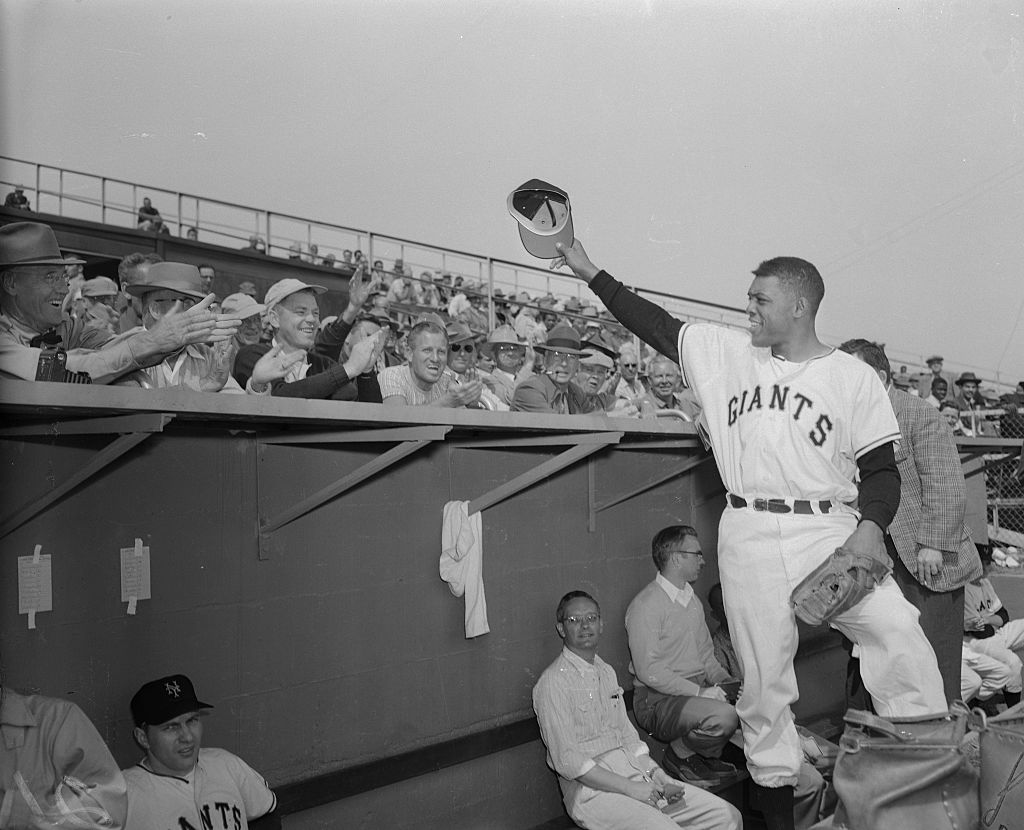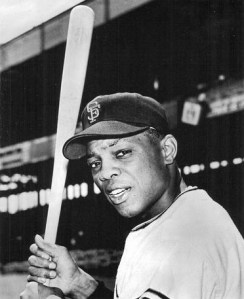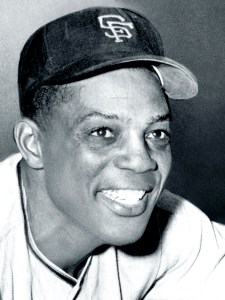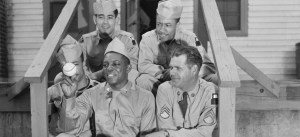

Highlights

The great legend himself, “the Say Hey Kid,” Mr. Willie Mays has passed away at 93. He leaves behind a legacy of work, passion and being a team player in a day when such elements are sometimes lacking, yet still championed. Mays played 23 years in Major League Baseball and is one of the most popular players of all time. He earned Rookie of the Year in 1951, his inaugural season for the New York Giants. Yes, that’s right, back when the Big Apple had a baseball team named the Giants. His lifetime batting average is .301 with 660 home runs and 1909 runs batted in, superb numbers in any era of baseball. Mays was a superstar in the days before fitness gurus, fad diets and “supplements,” so it makes you wonder what he could have accomplished today with his spectacular abilities.
Mays was World Series champion (1954) with the famous over-the-shoulder catch in Game 1, a 24-time All-Star, a 12-time consecutive Gold Glove winner and was inducted into the Baseball Hall of Fame in 1979, his first year of eligibility. He was awarded the Presidential Medal of Freedom in 2015. Before his baseball and life success, he was born and raised in Westfield, Alabama. He was a gifted athlete growing up and played multiple sports. Mays broke into professional baseball in 1948 with the Chattanooga Choo-Choos, a Negro American League and then moved over to the Birmingham Black Barons. Mays helped the Black Barons go to the 1948 Negro World Series, which they unfortunately lost to the Homestead Grays.

He was on his way to the majors post his performance on the Black Barons and his graduation from high school. Yes, he played pro ball while still in high school and was signed by the New York Giants for their Class B Trenton Giants in 1950. He moved up to Triple-A with the Minneapolis Millers in 1951 batting a hearty .477. Mays was called up to the majors, every baseball-loving kid’s dream, on May 24, 1951, for the Giants. His rookie season was a success on many levels and he held a batting average of .274 with 20 homers and 68 runs batted in. After the season he was drafted by the US Army to serve in the Korean War.

Mays was inducted into the Army on May 29, 1951, at Fort Eustis, Virginia. His service involved the continued improvement of his baseball game where he learned the basket catch from a fellow ball player named Al Fortunato. Mays played on military baseball teams with other major league ball players during his time in uniform. His service cost him 266 pro ball games and he was discharged on March 1st, 1954.

Once back in the majors, Mays continued his ascendency to greatness with the Giants. He adjusted his batting stance and was selected to the NL All-Star team for his markedly improved performance. Mays batted an impressive .345 with 41 homers and 110 runs batted in. Not only did his performance improve, so did the Giants as they won the World Series over the Cleveland Indians. Mays had a crucial catch in Game 1, known as The Catch. He caught a deep fly ball from Vic Wertz in center field with runners on base in scoring position and with his over-the-shoulder catch and throwback to the infield, he highly influenced the Giants to their World Series win.

Mays’s career continued with the Giants as they moved from New York to San Francisco, which included more All-Star level performances and being made the highest-paid baseball player in 1959 with a $75,000 contract. The Giants again appeared in the World Series, this time in 1962 against the Yankees. Mays played well and the team stretched the series to seven games against the ole Yanks, but they lost in seven. Mays batted .250 overall in the series and hit a deep ball in game seven that may have been enough to score the tying run, however, the runner was held at third base. The Yankees went on to win on the next play when the batter was caught out on a line drive. Mays would not appear in another World Series as a Giant while hitting 51 homers that year. The next season Mays earned another record-setting contract at $105,000 per season and he was made the Giants’ captain, the first African-American captain in the MLB. He earned his second NL MVP in 1965, which is the same season he hit his 500th career home run and was second in line to Babe Ruth in home runs at the end of the season (Ruth with 714 and Mays with 542). Mays earned Player of the Decade accolades for the 1960s from Sporting News.

He continued his leadership and high-level performance into the 1970s in center field and some time at first base. He was nominated for the Roberto Clemente Award in 1971, given to the MLB player who, “best exemplifies the game of baseball, sportsmanship, community involvement and the individual’s contribution to his team.” He eventually was traded from the Giants to the New York Mets and returned to his major league roots in the Empire City. In 1973, he helped the Mets win the NL East and his 660th home run. The Mets advanced to the World Series against the Oakland Athletics. Mays played valiantly in his last shot at a Series win with the Mets pushing seven games against the Athletics, however, they lost.

Mays retired after the season and stayed with the Mets as their hitting instructor for six years. He also served as a special assistant to the president and general manager of the Giants in 1986. Mays signed a lifetime contract with the Giants in 1993 and gathered support for the Giants’ new Pac Bell Park that opened in 2000. His number 24 has been retired by the Giants and Mets. He spent time with many high-level dignitaries and Presidents such as Queen Elizabeth II and Presidents of the United States such as Barrack Obama, Ronald Reagan, George W. Bush and Gerald Ford. The MLB World Series MVP award is named the Willie Mays World Series MVP Award and he even appeared on many TV shows such as What’s My Line?, The Donna Reed Show, The Dating Game, Bewitched and was mentioned in the Peanuts comic strip many times.
Mays left an indelible impact on the world of sports, pop culture and life. He served his country and brought to joy millions of fans worldwide. May he rest in peace and his legacy continue to inspire people for generations.
The great legend himself, “the Say Hey Kid,” Mr. Willie Mays passed away at 93. He leaves behind a legacy of work, passion and being a team player in a day when such elements are sometimes lacking. Mays played 23 years in Major League Baseball and is one of the most popular players of all time. He earned Rookie of the Year in 1951, his inaugural season for the New York Giants. Yes, that’s right, back when the Big Apple had a baseball team named the Giants. His lifetime batting average is .301 with 660 home runs and 1909 runs batted in, superb numbers in any era of baseball. Mays was a superstar in the days before fitness gurus, fad diets and “supplements,” so it makes you wonder what he could have accomplished today with his spectacular abilities.
Mays was World Series champion (1954), a 24-time All-Star, a 12-time consecutive Gold Glove winner and was inducted into the Baseball Hall of Fame in 1979 — his first year of eligibility. He was awarded the Presidential Medal of Freedom in 2015. Before his baseball and life success, he was born and raised in Westfield, Alabama. He was a gifted athlete growing up and played multiple sports. Mays broke into professional baseball in 1948 with the Chattanooga Choo-Choos, a Negro American League and then moved over to the Birmingham Black Barons. Mays helped the Black Barons go to the 1948 Negro World Series, which they unfortunately lost to the Homestead Grays.

He was on his way to the majors post-performance on the Black Barons and his graduation from high school. Yes, he played pro ball while still in high school and was signed by the New York Giants for their Class B Trenton Giants in 1950. He moved up to Triple-A with the Minneapolis Millers in 1951 batting a hearty .477. Mays was called up to the majors, every baseball-loving kid’s dream, on May 24, 1951, for the Giants. His rookie season was a success on many levels and he held a batting average of .274 with 20 homers and 68 runs batted in. After the season he was drafted by the US Army to serve in the Korean War.
Mays was sworn into the Army on May 29, 1951, at Fort Eustis, Virginia. His service involved the continued improvement of his baseball game where he learned the basket catch from a fellow ball player named Al Fortunato. Mays played on military baseball teams with other major league ball players during his time in uniform. His service cost him 266 pro ball games and he was discharged on March 1st, 1954.
Once back in the majors, Mays continued his ascendency to greatness with the Giants. He adjusted his batting stance and was selected to the NL All-Star team for his markedly improved performance. Mays batted an impressive .345 with 41 homers and 110 runs batted in. Not only did his performance improve, so did the Giants, as they won the World Series over the Cleveland Indians. Mays had a crucial catch in Game 1, known as The Catch. He caught a deep fly ball from Vic Wertz in center field with runners on base in scoring position and with his over-the-shoulder catch and throwback to the infield, he highly influenced the Giants to their World Series win.

Mays’s career continued with the Giants as they moved from New York to San Francisco, which included more All-Star level performances and being made the highest-paid baseball player in 1959 with a $75,000 contract. The Giants again appeared in the World Series, this time in 1962 against the Yankees. Mays played well and the team stretched the series to seven games against the ole Yanks, but they lost in seven. Mays batted .250 overall in the series and hit a deep ball in Game 7 that may have been enough to score the tying run, however, the runner was held at third base. The Yankees went on to win on the next play when the batter was caught out on a line drive. Mays would not appear in another World Series as a Giant while hitting 51 homers that year. The next season Mays earned another record-setting contract at $105,000 per season and he was made the Giants’ captain, the first African-American captain in the MLB. He earned his second NL MVP in 1965, which is the same season he hit his 500th career home run and was second in line to Babe Ruth in home runs at the end of the season (Ruth with 714 and Mays with 542). Mays earned Player of the Decade accolades for the 1960s from Sporting News.

He continued his leadership and high-level performance into the 1970s in center field and some time at first base. He was nominated for the Roberto Clemente Award in 1971, given to the MLB player who, “best exemplifies the game of baseball, sportsmanship, community involvement and the individual’s contribution to his team.” He eventually was traded from the Giants to the New York Mets and returned to his major league roots in the Empire City. In 1973, he helped the Mets win the NL East and hit his 660th home run. The Mets advanced to the World Series against the Oakland Athletics. Mays played valiantly in his last shot at a Series win with the Mets pushing seven games against the Athletics, however, they lost.

Mays retired after the season and stayed with the Mets as their hitting instructor for six years. He also served as a special assistant to the president and general manager of the Giants in 1986. Mays signed a lifetime contract with the Giants in 1993 and gathered support for the Giants’ new Pac Bell Park that opened in 2000. His number 24 has been retired by the Giants and Mets. He spent time with many high-level dignitaries and Presidents such as Queen Elizabeth II and Presidents of the United States such as Barrack Obama, Ronald Reagan, George W. Bush and Gerald Ford. The MLB World Series MVP award is named the Willie Mays World Series MVP Award and he even appeared on many TV shows such as What’s My Line?, The Donna Reed Show, The Dating Game, Bewitched and was mentioned in the Peanuts comic strip many times.
Mays left an indelible impact on the world of sports, pop culture and life. He served his country and brought to joy millions of fans worldwide. May he rest in peace and his legacy continue to inspire people for generations.
